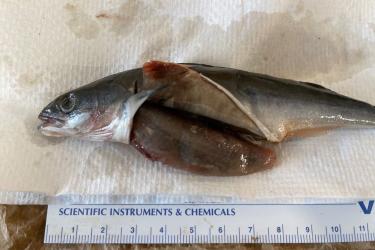Five independent reviewers have found that NOAA Fisheries' “Nearshore Calculator” is based on the best available science. Our scientists developed the tool to assess the value of salmon habitat in Puget Sound. The professional feedback indicates that the calculator can help accurately estimate the effects of development, and what it will take to offset that impact.
In one of the reviews, Steven J. Cooke of Carleton University praised the way the calculator was “thoughtfully developed drawing upon published literature, grey literature, and expert knowledge.”
NOAA Fisheries developed the calculator to help developers and other project proponents quantify the impact of their projects on the value of salmon habitat. Puget Sound’s nearshore habitat is especially important to juvenile Chinook salmon during their first few months in saltwater, before they leave for years in the open ocean. The larger the fish are when they set off, the better their odds of surviving and returning to their home rivers to spawn.
We published three biological opinions between 2020 to 2022 assessing the impacts of development projects such as bulkheads and piers on salmon habitat. They determined that further losses of nearshore habitat in Puget Sound were likely to jeopardize the existence of threatened Puget Sound Chinook salmon and endangered Southern Resident killer whales.
Following those opinions, the Army Corps of Engineers’ 2022 Salish Sea Nearshore Programmatic Biological Opinion required project proponents to offset the impacts of their projects on the habitat. The Nearshore Calculator provides a scientifically based means of valuing lost salmon habitat so developers know up-front how much they must offset.
Proponents Have Options
Developers have several options to offset the impacts. They can work with willing partners to restore nearby habitat or purchase credits to cover the value of the habitat that is lost. The credits typically represent a share in a conservation bank or an in-lieu fee program that restores damaged habitat.
As use of the calculator increased, we sought outside peer reviews of the calculator and the science behind it. The NOAA Fisheries Office of Science & Technology contracted with the Center of Independent Experts to provide the scientific peer reviews without any influence from the agency. Reviewer Robert Lennox concluded that, “the Nearshore Calculator goes to great lengths to find and interpret published evidence and, in their absence, uses opinions of experts to establish a comprehensive evidence base for the tool.”
“We’re glad to have the value of this science-based application acknowledged,” said Kim Kratz, Assistant Regional Administrator for the Oregon and Washington Coastal Office in NOAA Fisheries West Coast Region. “The point is to provide options. The calculator helps those affected determine what design and mitigation options work best for them.”
Providers Offer Credits
NOAA Fisheries has identified several local providers of conservation credits, which use funding from the credits to support habitat renewal. They include:
- Blue Heron Slough Conservation Bank
- Hood Canal In-Lieu Fee Mitigation Program
- Puget Sound Partnership Nearshore Habitat Conservation Credit Program.
The credit program developed by the Puget Sound Partnership has provided increasing numbers of conservation credits since it started in 2021. Project proponents purchased nearly $3 million worth of credits in 2023. The cost of the credits has funded projects such as the removal of derelict piles, piers, and barges that have damaged and degraded salmon habitat.
The reviews also suggested improvements to the calculator. For example, two reviewers cautioned that restoration or mitigation efforts to offset impacts may not always provide all the anticipated ecological benefits. We will incorporate the feedback to improve the tool.
The expert reviews confirmed that the calculator is a well-informed and reliable tool, as described by reviewer Steven F. Railsback of Cal Poly Humboldt. He said it adopted a “practical and credible method” for examining shoreline habitat. He concluded, “[t]he basis in mechanisms, and the authors’ extensive reviews of supporting literature, provide a credible basis for model assumptions and weighting scores.”



